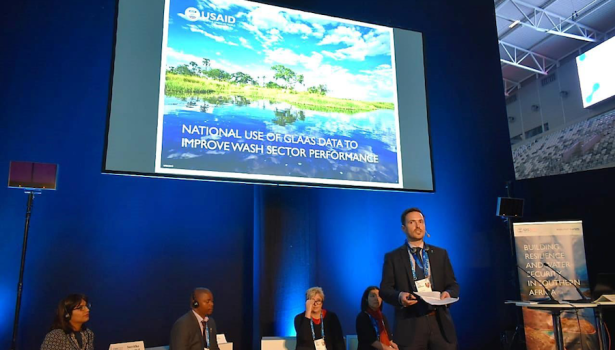USAID Southern Africa Program Acknowledged in 2019 GLAAS Report
The USAID Resilient Waters Program presented alongside the Global Analysis and Assessment for Sanitation and Drinking Water (GLAAS) team at the Stockholm World Water Week 2019 conference at the end of August. GLAAS is a UN-Water initiative implemented by the World Health Organization (WHO). The showcase of Resilient Waters took place at a session to launch the 2019 GLAAS Report. The Resilient Waters Program has been acknowledged in the 2019 GLAAS report for “using GLAAS data to guide development programs.”
The GLAAS report provides a global update on the WASH sector performance of about 100 countries. According to the WHO, “The objective of GLAAS is to provide policy- and decision-makers at all levels with a reliable, easily accessible, comprehensive and global analysis of the investments and enabling environment to make informed decisions for sanitation, drinking-water and hygiene.” For the 2018/2019 cycle, WHO GLAAS surveyed 115 countries, a significant number of which are aiming to achieve universal access to WASH by 2030—the objective of Sustainable Development Goal 6.
In southern Africa the achievement of universal coverage by 2030 is still a major challenge as 40 percent of people do not have access to safe drinking water and 60 percent lack access to improved sanitation facilities. One of the objectives of the USAID Resilient Waters Program is to increase access to safe drinking water and sanitation services in southern Africa. To this end, Resilient Waters has been working at a national level and using GLAAS data to improve WASH sector performance.
As mentioned in the 2019 GLAAS report, “Resilient Waters has organized gap analysis workshops in Botswana, Mozambique, Namibia, South Africa and Zimbabwe, based on their GLAAS 2018/2019 country survey submissions to inform potential program activities that are aligned with national objectives. These workshops building on the GLAAS process have allowed Resilient Waters to immediately get started with stakeholder buy-in. For example, in Botswana, the GLAAS gap analysis highlighted that sanitation has lagged behind water supply, and the response from the Ministry of Land Management, Water and Sanitation Services and Resilient Waters has been able to develop a Sanitation Roadmap, which will be delivered within six months of the GLAAS survey submission.” Resilient Waters is the only development program to be acknowledged in the report, which is testament to the success of this initiative.
Through this process Resilient Waters has demonstrated how GLAAS can be used as a mechanism to build buy-in and sector coordination at a national level and to speed up the implementation of interventions that address national-level bottlenecks in WASH. In essence, Resilient Waters has developed a gap analysis tool that can be rolled out in other countries and regions around the world. Going forward, the Resilient Waters Program will work closely with Botswana, Mozambique, Namibia, South Africa, and Zimbabwe to prioritize and implement WASH interventions in their countries.
By Nandipha Kunaka, Communications Specialist, USAID’s Resilient Waters Program
USAID Resilient Waters is a five-year, $32 million project implemented by Chemonics International. Its goal is to build more resilient and water secure southern African communities and ecosystems through improved management of transboundary natural resources and increased access to safe drinking water and sanitation services.


